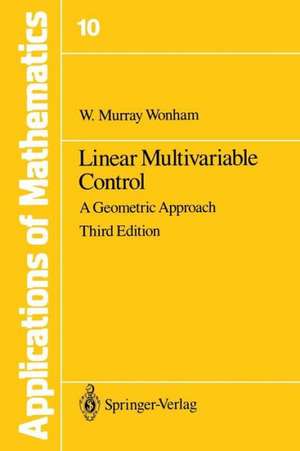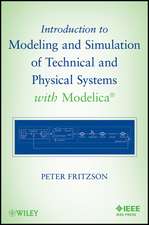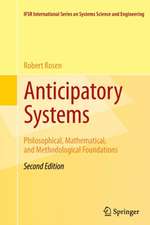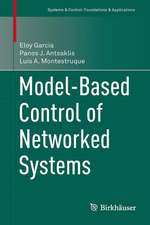Linear Multivariable Control: A Geometric Approach: Stochastic Modelling and Applied Probability, cartea 10
Autor W.M. Wonhamen Limba Engleză Paperback – 28 oct 2012
| Toate formatele și edițiile | Preț | Express |
|---|---|---|
| Paperback (1) | 947.35 lei 6-8 săpt. | |
| Springer – 28 oct 2012 | 947.35 lei 6-8 săpt. | |
| Hardback (1) | 1116.57 lei 6-8 săpt. | |
| Springer – dec 1985 | 1116.57 lei 6-8 săpt. |
Din seria Stochastic Modelling and Applied Probability
- 17%
 Preț: 464.60 lei
Preț: 464.60 lei - 18%
 Preț: 805.44 lei
Preț: 805.44 lei - 18%
 Preț: 1110.72 lei
Preț: 1110.72 lei -
 Preț: 390.84 lei
Preț: 390.84 lei - 18%
 Preț: 952.40 lei
Preț: 952.40 lei - 15%
 Preț: 648.56 lei
Preț: 648.56 lei - 18%
 Preț: 951.91 lei
Preț: 951.91 lei - 15%
 Preț: 637.13 lei
Preț: 637.13 lei - 18%
 Preț: 793.63 lei
Preț: 793.63 lei -
 Preț: 391.02 lei
Preț: 391.02 lei -
 Preț: 401.42 lei
Preț: 401.42 lei - 15%
 Preț: 639.08 lei
Preț: 639.08 lei - 18%
 Preț: 733.33 lei
Preț: 733.33 lei - 18%
 Preț: 785.11 lei
Preț: 785.11 lei - 15%
 Preț: 593.42 lei
Preț: 593.42 lei - 18%
 Preț: 1114.96 lei
Preț: 1114.96 lei - 15%
 Preț: 643.16 lei
Preț: 643.16 lei -
 Preț: 390.63 lei
Preț: 390.63 lei - 15%
 Preț: 645.60 lei
Preț: 645.60 lei - 15%
 Preț: 641.71 lei
Preț: 641.71 lei - 18%
 Preț: 954.62 lei
Preț: 954.62 lei - 15%
 Preț: 645.14 lei
Preț: 645.14 lei - 18%
 Preț: 947.50 lei
Preț: 947.50 lei - 18%
 Preț: 804.96 lei
Preț: 804.96 lei - 15%
 Preț: 644.63 lei
Preț: 644.63 lei - 20%
 Preț: 469.59 lei
Preț: 469.59 lei - 20%
 Preț: 581.39 lei
Preț: 581.39 lei
Preț: 947.35 lei
Preț vechi: 1155.30 lei
-18% Nou
Puncte Express: 1421
Preț estimativ în valută:
181.27€ • 189.77$ • 149.99£
181.27€ • 189.77$ • 149.99£
Carte tipărită la comandă
Livrare economică 05-19 aprilie
Preluare comenzi: 021 569.72.76
Specificații
ISBN-13: 9781461270058
ISBN-10: 1461270057
Pagini: 356
Ilustrații: XVI, 334 p.
Dimensiuni: 155 x 235 x 22 mm
Greutate: 0.5 kg
Ediția:3rd ed. 1985. Softcover reprint of the original 3rd ed. 1985
Editura: Springer
Colecția Springer
Seria Stochastic Modelling and Applied Probability
Locul publicării:New York, NY, United States
ISBN-10: 1461270057
Pagini: 356
Ilustrații: XVI, 334 p.
Dimensiuni: 155 x 235 x 22 mm
Greutate: 0.5 kg
Ediția:3rd ed. 1985. Softcover reprint of the original 3rd ed. 1985
Editura: Springer
Colecția Springer
Seria Stochastic Modelling and Applied Probability
Locul publicării:New York, NY, United States
Public țintă
ResearchCuprins
0 Mathematical Preliminaries.- 0.1 Notation.- 0.2 Linear Spaces.- 0.3 Subspaces.- 0.4 Maps and Matrices.- 0.5 Factor Spaces.- 0.6 Commutative Diagrams.- 0.7 Invariant Subspaces. Induced Maps.- 0.8 Characteristic Polynomial. Spectrum.- 0.9 Polynomial Rings.- 0.10 Rational Canonical Structure.- 0.11 Jordan Decomposition.- 0.12 Dual Spaces.- 0.13 Tensor Product. The Sylvester Map.- 0.14 Inner Product Spaces.- 0.15 Hermitian and Symmetric Maps.- 0.16 Well-Posedness and Genericity.- 0.17 Linear Systems.- 0.18 Transfer Matrices. Signal Flow Graphs.- 0.19 Rouché’s Theorem.- 0.20 Exercises.- 0.21 Notes and References.- 1 Introduction to Controllability.- 1.1 Reachability.- 1.2 Controllability.- 1.3 Single-Input Systems.- 1.4 Multi-Input Systems.- 1.5 Controllability is Generic.- 1.6 Exercises.- 1.7 Notes and References.- 2 Controllability, Feedback and Pole Assignment.- 2.1 Controllability and Feedback.- 2.2 Pole Assignment.- 2.3 Incomplete Controllability and Pole Shifting.- 2.4 Stabilizability.- 2.5 Exercises.- 2.6 Notes and References.- 3 Observability and Dynamic Observers.- 3.1 Observability.- 3.2 Unobservable Subspace.- 3.3 Full Order Dynamic Observer.- 3.4 Minimal Order Dynamic Observer.- 3.5 Observers and Pole Shifting.- 3.6 Detectability.- 3.7 Detectors and Pole Shifting.- 3.8 Pole Shifting by Dynamic Compensation.- 3.9 Observer for a Single Linear Functional.- 3.10 Preservation of Observability and Detectability.- 3.11 Exercises.- 3.12 Notes and References.- 4 Disturbance Decoupling and Output Stabilization.- 4.1 Disturbance Decoupling Problem (DDP).- 4.2 (A, B)-Invariant Subspaces.- 4.3 Solution of DDP.- 4.4 Output Stabilization Problem (OSP).- 4.5 Exercises.- 4.6 Notes and References.- 5 Controllability Subspaces.- 5.1 Controllability Subspaces.- 5.2 Spectral Assignability.- 5.3 Controllability Subspace Algorithm.- 5.4 Supremal Controllability Subspace.- 5.5 Transmission Zeros.- 5.6 Disturbance Decoupling with Stability.- 5.7 Controllability Indices.- 5.8 Exercises.- 5.9 Notes and References.- 6 Tracking and Regulation I: Output Regulation.- 6.1 Restricted Regulator Problem (RRP).- 6.2 Solvability of RRP.- 6.3 Example 1 : Solution of RRP.- 6.4 Extended Regulator Problem (ERP).- 6.5 Example 2: Solution of ERP.- 6.6 Concluding Remarks.- 6.7 Exercises.- 6.8 Notes and References.- 7 Tracking and Regulation II: Output Regulation with Internal Stability.- 7.1 Solvability of RPIS: General Considerations.- 7.2 Constructive Solution of RPIS: N= 0.- 7.3 Constructive Solution of RPIS: N Arbitrary.- 7.4 Application: Regulation Against Step Disturbances.- 7.5 Application: Static Decoupling.- 7.6 Example 1 : RPIS Unsolvable.- 7.7 Example 2: Servo-Regulator.- 7.8 Exercises.- 7.9 Notes and References.- 8 Tracking and Regulation III: Structurally Stable Synthesis.- 8.1 Preliminaries.- 8.2 Example 1: Structural Stability.- 8.3 Well-Posedness and Genericity.- 8.4 Well-Posedness and Transmission Zeros.- 8.5 Example 2: RPIS Solvable but Ill-Posed.- 8.6 Structurally Stable Synthesis.- 8.7 Example 3: Well-Posed RPIS: Strong Synthesis.- 8.8 The Internal Model Principle.- 8.9 Exercises.- 8.10 Notes and References.- 9 Noninteraeting Control I: Basic Principles.- 9.1 Decoupling: Systems Formulation.- 9.2 Restricted Decoupling Problem (RDP).- 9.3 Solution of RDP: Outputs Complete.- 9.4 Extended Decoupling Problem (EDP).- 9.5 Solution of EDP.- 9.6 Naive Extension.- 9.7 Example.- 9.8 Partial Decoupling.- 9.9 Exercises.- 9.10 Notes and References.- 10 Noninteraeting Control II: Efficient Compensation.- 10.1 The Radical.- 10.2 Efficient Extension.- 10.3 Efficient Decoupling.- 10.4 Minimal Order Compensation: d(?) = 2.- 10.5 Minimal Order Compensation: d(?) = k.- 10.6 Exercises.- 10.7 Notes and References.- 11 Noninteraeting Control III: Generic Solvability.- 11.1 Generic Solvability of EDP.- 11.2 State Space Extension Bounds.- 11.3 Significance of Generic Solvability.- 11.4 Exercises.- 11.5 Notes and References.- 12 Quadratic Optimization I: Existence and Uniqueness.- 12.1 Quadratic Optimization.- 12.2 Dynamic Programming: Heuristics.- 12.3 Dynamic Programming: Formal Treatment.- 12.4 Matrix Quadratic Equation.- 12.5 Exercises.- 12.6 Notes and References.- 13 Quadratic Optimization II: Dynamic Response.- 13.1 Dynamic Response: Generalities.- 13.2 Example 1 : First-Order System.- 13.3 Example 2: Second-Order System.- 13.4 Hamiltoman Matrix.- 13.5 Asymptotic Root Locus: Single Input System.- 13.6 Asymptotic Root Locus: Multivariable System.- 13.7 Upper and Lower Bounds on P0.- 13.8 Stability Margin. Gain Margin.- 13.9 Return Difference Relations.- 13.10 Applicability of Quadratic Optimization.- 13.11 Exercises.- 13.12 Notes and References.- References.- Relational and Operational Symbols.- Letter Symbols.- Synthesis Problems.













